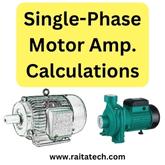
How to calculate ampere for a single-phase motor?
Hello guys, In the post I have shared motor ampere calculations.
To calculate the amperes for a single-phase motor, you will need to know the horsepower rating of the motor and the voltage at which it is being operated. Once you have this information, you can use the following formula of motor ampere calculations:
Amps = (Horsepower × 746) / Voltage
For example, if you have a 1 horsepower (hp) motor that is operating at 120 volts, you can calculate the current in amps by using the formula:
Amps = (1 × 746) / 120 = 6.216 amps.
It’s important to note that the formula above is an approximation, the actual current drawn by a motor can vary depending on the load, and other factors such as power factor, efficiency, and voltage variations. To have a precise measurement it is better to use a clamp ammeter or other measuring devices.
Another important factor to consider when calculating the amperes for a single-phase motor is the power factor (PF). The power factor is the ratio of real power (watts) to apparent power (volt-amps) and it varies between 0 and 1. A low power factor results in a higher current draw and can cause problems with the electrical supply and other equipment.
The formula for calculating amperes with power factor correction is:
Amps = (Horsepower × 746) / (Voltage × Power Factor)
It’s also worth noting that some motors are designed to operate at different voltage levels and have a different full load current rating for each voltage. So, it’s important to check the motor nameplate for the current rating at the voltage the motor will be operating at.
It is also important to keep in mind that these calculations are for the full load current, if you are running the motor at a lower load, the current will also be lower.
Additionally, many motors come with a nameplate that shows the full load current which can be used directly and doesn’t need any calculations.
In summary, calculating the amperes for a single-phase motor requires knowledge of the motor horsepower, voltage, and power factor, and it is advisable to check the nameplate of the motor for a precise full load current rating.
Example:
here’s an example of how to calculate the amperes for a single-phase motor:
Let’s say you have a 2-horsepower (hp) single-phase motor that will be operating at 230 volts. You also know that the power factor of the motor is 0.85. To calculate the amperes, you would use the following formula:
Amps = (2 × 746) / (230 × 0.85) = 11.16 amps
This means that the motor will draw 11.16 amps at full load when operating at 230 volts and with a power factor of 0.85.
It’s important to note that this is an estimation and the actual current draw may vary depending on the load, power factor, efficiency, and voltage variations. If you have the opportunity to measure the current with a clamp ammeter or other measuring devices while the motor is running, that would give you a more accurate reading.
It’s also worth checking the nameplate of the motor to see if it specifies the full load current rating for the voltage the motor will be operating at. This will give you a more accurate value.

